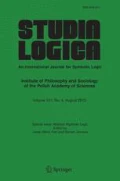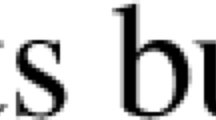Abstract
We present a formal system for reasoning about inclusion and exclusion in natural language, following work by MacCartney and Manning. In particular, we show that an extension of the Monotonicity Calculus, augmented by six new type markings, is sufficient to derive novel inferences beyond monotonicity reasoning, and moreover gives rise to an interesting logic of its own. We prove soundness of the resulting calculus and discuss further logical and linguistic issues, including a new connection to the classes of weak, strong, and superstrong negative polarity items.
Similar content being viewed by others
References
Barwise J., Cooper R.: Generalized quantifiers and natural language. Linguistics and Philosophy 4, 159–219 (1981)
van Benthem J.: Essays in Logical Semantics. Reidel, Dordrecht (1986)
van Benthem J.: Language in Action. North Holland, Amsterdam (1991)
van Benthem, J., Natural logic: a view from the 1980’s, in M. K. Chakraborty et al. (eds.), Logic, Navya-Nyāya and Applications, College Publications, London, 2008.
Giannakidou, A., Negative and positive polarity items, in C. Maienborn, K. von Heusinger, and P. Portner (eds.), Semantics: An International Handbook of Natural Language Meaning, Mouton de Gruyter, 2011.
Hoeksema J.: Negative polarity and the comparative. Natural Language and Linguistic Theory 1, 403–434 (1983)
Ladusaw, W., Polarity Sensitivity as Inherent Scope Relations, Ph.D. Dissertation, University of Texas Austin, 1979.
MacCartney, B., Natural Language Inference, Ph.D. Dissertation, Stanford University, 2009.
MacCartney, B., and C. D. Manning, Modeling semantic containment and exclusion in natural language inference, The 22nd International Conference on Computational Linguistics (Coling-08), Manchester, 2008.
MacCartney, B., and C. D. Manning, An extended model of natural logic, Proceedings of the Eighth International Conference on Computational Semantics, 2009.
Moss, L. S., Logics for Natural Language Inference, ESSLLI 2010 Course Notes.
Moss, L. S., The Soundness of Internalized Polarity Marking, Studia Logica 100(4):683–704, 2012. (this issue)
Sánchez, V., Studies on Natural Logic and Categorial Grammar, Ph.D. Dissertation, Universiteit van Amsterdam, 1991.
Suppes P.: Logical inference in English. Studia Logica 38(4), 375–391 (1979)
Zamansky A., Francez N., Winter Y.: A ’natural logic’ inference system using the Lambek Calculus. Journal of Logic, Language, and Information 15(3), 273–295 (2006)
Zwarts, F., Three types of polarity, in F. Hamm and E. Hinrichs (eds.), Plurality and Quantification, Kluwer, 1998.
Author information
Authors and Affiliations
Corresponding author
Rights and permissions
About this article
Cite this article
Icard, T.F. Inclusion and Exclusion in Natural Language. Stud Logica 100, 705–725 (2012). https://doi.org/10.1007/s11225-012-9425-8
Published:
Issue Date:
DOI: https://doi.org/10.1007/s11225-012-9425-8




